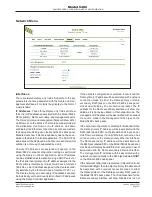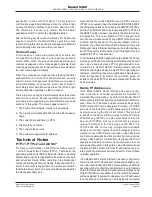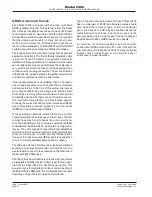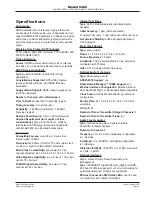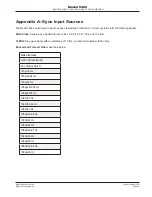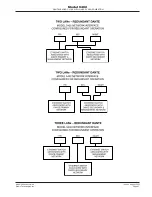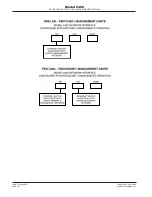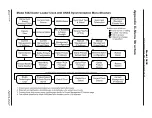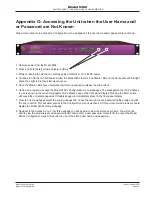
Model 5402 User Guide
Issue 3, August 2021
Studio Technologies, Inc.
Page 39
Model 5402
DANTE LEADER CLOCK WITH GNSS SYNCHRONIZATION
pushbutton on the unit’s front panel. This will lead to a
confirmation page being displayed. Use the left and right
arrow pushbutton switches to select the desired action.
The choices are to cancel or to confirm. Press the Enter
pushbutton switch to select the highlighted action.
After performing a system reboot (restart), 20 to 60 seconds
may be required for the Model 5402’s operation to fully
restore. During this time period the management Ethernet
port will briefly disconnect and then reconnect.
Screen Saver
A “screen saver” mode will automatically activate two
minutes after the last press of a front-panel pushbutton
switch. When active, the screen saver mode will cause a
continuous sequence of six menu pages to activate. Each
menu page will be present for about three seconds before
the next menu page will display.
When the screen saver mode is active pressing the Enter
pushbutton switch on the front panel will cause it to stop
and the current management IP address menu page to
immediate display. To cause the screen saver mode to
immediately start simultaneously press the left and right
arrow pushbutton switches on the front panel.
There are six menu pages that will display when the screen
saver mode is active. Details regarding the information
provided in menu pages 2-6 were documented in previously
sections of this guide. The menu pages consist of:
1. The Studio Technologies’ company logo graphic.
2. The product name (Model 5402) and the Dante device
name.
3. The current date and time (in UTC).
4. The Dante sync status.
5. The current clock source.
6. The current management IP address.
Technical Notes
PTPv1, PTPv2, and AES67
For clock synchronization “native” Dante utilizes version
1 of the Precision Time Protocol (PTPv1). Technically, the
applicable standard is IEEE 1588-2002, which is what the
Model 5402 supports for applications that utilize both single
and redundant Dante. When operating in the Redundant
or ReMgmt network modes, independent PTPv1
server functionality is supported, one instance provided for
the Dante primary port and a second instance provided for
the Dante secondary port.
Applications that utilize AES67 require PTP version 2
(PTPv2) as covered under the standard IEEE 1588-2008.
(And following details as specified in the SMPTE ST2059-2
profile.) The Model 5402 will provide support for PTPv2 if
the AES67 mode has been enabled in the Dante Control-
ler application. This is in addition to PTPv1 support; both
can function simultaneously. When AES67 mode has been
enabled and Redundant or ReMgmt mode is
selected, then both the Model 5402’s Dante primary and
Dante secondary Ethernet interfaces will provide indepen-
dent PTPv2 server functionality. (And to highlight, this is in
addition to PTPv1 functionality.)
In Dante-related AES67 applications the Model 5402 can
provide good PTPv2 functionality. But the Model 5402 can’t
serve as a general-purpose PTPv2 grandmaster clock.
Limitations in Dante’s AES67 implementation restricts
Studio Technologies’ ability to adjust PTPv2 operating pa-
rameters, something that some applications may require.
Refer to Appendix F, located at the end of the guide, for
details on the default PTPv2 implementation that the Model
5402 provides.
Dante IP Addresses
If the Model 5402’s Dante interface has been config-
ured in the Dante Controller application for Switched or
SMgmt operation, by default the Model 5402’s
Dante primary Ethernet interfaces will attempt to automati-
cally obtain an IP address and associated settings using
DHCP (Dynamic Host Configuration Protocol). If a DHCP
server is not detected then an IP address will automatically
be assigned using the link-local protocol. This protocol
is known in the Microsoft® world as Automatic Private
IP Addressing (APIPA). It is also sometimes referred to
as auto-IP (PIPPA). Link-local will randomly assign a
unique IP address in the IPv4 range of 169.254.0.1 to
169.254.255.254. In this way, multiple Dante-enabled
devices will connect together and automatically function,
whether or not a DHCP server is active on the LAN. Even
two Dante-enabled devices that are directly interconnected
using an RJ45 patch cord should correctly acquire IP ad-
dresses and be able to communicate with each other. As
previously discussed in this guide, using Dante Controller
the Model 5402’s Dante Ethernet IP address(es) and re-
lated network parameters can also be set for manual (fixed
or static) operation.
If the Model 5402’s Dante interface has been configured in
Dante Controller for Redundant or ReMgmt oper-
ation then both the Model 5402’s Dante primary and Dante
secondary Ethernet interfaces will attempt to automatically
obtain IP addresses and associated network settings using
DHCP. If DHCP is not available then link-local IP addresses
will be assigned. If automatic assignment of IP addresses
is not desired each interface can be individually configured

